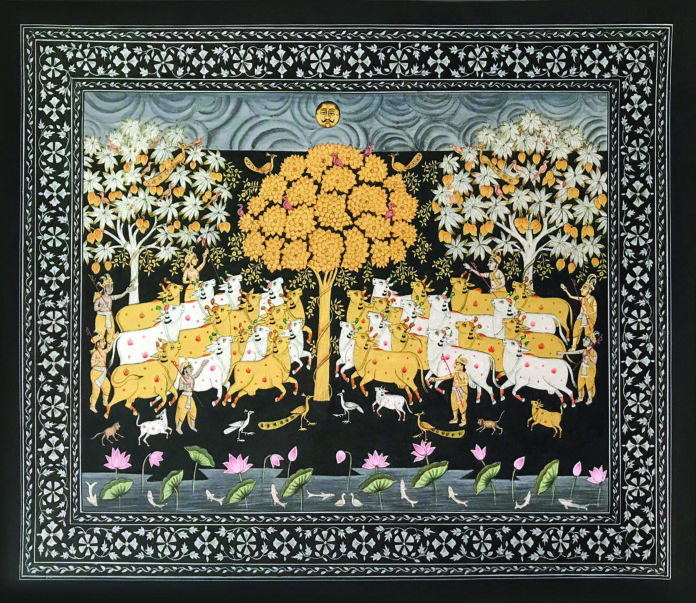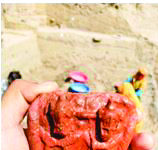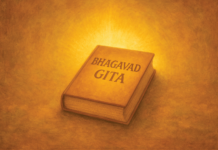Of India’s numerous art forms, Pichvai is one of the most easily recognised. Its universality, therefore, lends itself to being shown on a global scale. This summer, Pichvai art has made it to central London’s The Mall Galleries with the exhibition, ‘राग, भोग, श्रृंगार -Feast, Melody and Adornment’ running from July 2 – 6 2025. Spread across three spacious rooms, there are over 350 hand-painted Pichwai paintings on display at the exhibition.
Some are heritage pieces from Singhal’s personal collection which have been meticulously restored, while others reinterpret the 400-year-old tradition from Nathdwara within a contemporary context. For the last decade, Singhal has made it her mission to restore the historical techniques of this art form while ensuring that the intergenerational knowledge of its creation is preserved. Hence, she has taken the work of her atelier to the India Art Fair, Art Mumbai and Kochi-Muziris Biennale, as well as international art platforms.
Currently, it adorns one of London’s most renowned galleries in a firstof-its-kind exhibition. “A Pichvai is a meticulously detailed, hand-painted textile traditionally hung behind the idol of Shrinathji, a cherubic incarnation of the Indian deity Lord Krishna. The main shrine to Lord Krishna is in the temple town of Nathdwara in Udaipur, which has been a site of pilgrimage for centuries. The term ‘Pichvai’ is derived from the Sanskrit words pichh (back) and vai (hanging), reflecting its purpose as a backdrop for the idol.
These artworks had both ritualistic and commercial significance; large paintings were hung behind the idol within the temple as part of the seasonal adornment, while smaller versions were sold to pilgrims as sacred mementoes. These paintings served as visual relics, allowing devotees to carry an image of their deity back home, reinforcing their spiritual connection beyond the temple walls,” explains Singhal. She adds, “Feast, Melody and Adornment will include Pichvai featuring more traditional motifs of lotuses and the sacred Nandi cow, with highly intricate Deccan pieces showcasing the pinnacle of technical mastery in this art form, as well as more contemporary interpretations of Pichvai utilising a more minimalistic palette.” Singhal herself has a deeprooted connection to this artistic tradition, as she was born and raised near Nathdwara.
In 2015, she founded the atelier in Udaipur where master artists collaborate to bridge historical craftsmanship with contemporary artistic expression. In setting up the atelier, Singhal was also influenced by her mother’s patronage of the arts and royal craft traditions, as well as her Bachelor’s degree in Economics and Master’s degree in Business Administration from KATZ, University of Pittsburgh. When asked about the story behind the Pichvai art form, Singhal shares: “The tradition began with five artists being allowed into the sanctum during the darshans. They would sketch the deity in all its splendour and later transform their sketches into detailed paintings reflecting not only the deific representation of Shrinathji but also festival themes and stories from Krishna’s life.
These unsigned works, deeply embedded in devotional practice, illustrate not only the darshans but also the various festivals celebrated within the shrine, alongside the narratives and folklore of Krishna’s life. Over time, this tightly knit tradition expanded to a thriving artistic community of nearly 300 artists living in Chitrakaron ki Galli (lane of painters) in Nathdwara. While initially reserved for temple rituals, these artworks found their way into havelis, private homes and eventually international museums, and began to be appreciated for their intricate craftsmanship and cultural depth.” Traditionally, a Pichvai is hand-painted on cottonsilk fabric sourced from select mills in Rajasthan. Artists used mineral pigments derived from natural elements like emeralds, rubies and lapis lazuli.
Organic pigments would sometimes also be extracted from unusual sources like the yellow of cow urine fed on mangoes during summer. “The base cloth of the painting is coated with khadia, a white chalk paste mixed with natural adhesives to create a smooth, absorbent surface that enhances pigment adhesion and gives the Pichvai its muted earthy hues. The artist sketches the initial design using fine squirrel hairbrushes. Layers of ground mineral colours follow, finished with gold and silver foil.
The final step is likhai, a delicate outlining technique that adds definition and depth, bringing the intricate details to life,” says Singhal. Over a period of time, the art form declined owing to the disruption of the passing of knowledge through generations. This was further accelerated by the scarcity of essential materials. Hence, in 2009 Singhal decided to focus her efforts on this worthy project, aiming to transform the perception and appreciation of Pichvai art.
At the exhibition in London, the focus stays on Shrinathji’s traditional themes like Raag, Bhog and Shringar, which includes the Chappan Bhog, a sacred platter of 56 different dishes addressing the five tastes: sweet, sour, salty, spicy and bitter. Yet, Singhal also takes the art form to a more contemporary framework. She does this by highlighting sketches and monochromatic representations as an integral aspect of Pichvai, which is developed as the Greyscale series imagined as monochrome compositions as with archival black-andwhite photography.
She also fuses geometric patterns in vivid hues with the deconstructed elements of traditional works. Feast, Melody and Adornment by Pichvai Tradition & Beyond is on display at the Mall Galleries in London till July 6. Multiple free-toattend walkthroughs are being organised to accompany the exhibition. One can visit the website for more information.
Noor Anand Chawla pens lifestyle articles for various publications and her blog www. nooranandchawla.com.








